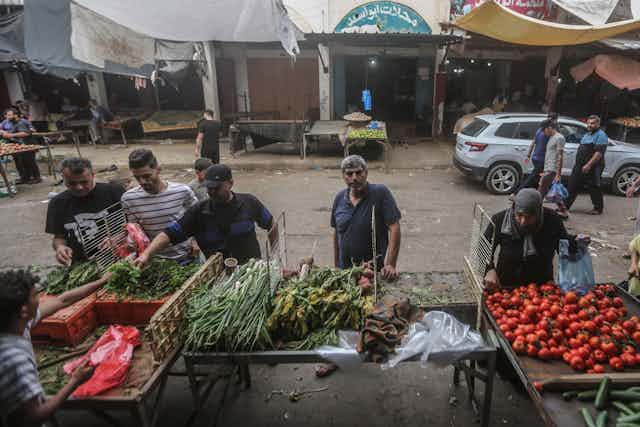More than half a million Gazans are currently facing “catastrophic hunger”, according to UN agencies. Reducing access to food is being used as a weapon in Gaza by the Israeli government.
Denying food to a civilian population is a tactic that has been used in conflicts for centuries. Starvation and malnutrition provide the attacker with a number of advantages. At the tactical level the enemy is denied mobility, is unable to sustain law and order among its population as vital foodstuffs become scarce, and the will to fight diminishes. Also the physical ability to fight is likely to erode.
Weakened bodies become susceptible to disease, while fear and hopelessness are enhanced due to the body’s inability to provide the brain with required nutrients. Fighters watch their families suffering and this can create doubt and guilt in their minds.
There are similarities between Israel’s tactic and the way strategic bombing in the second world war and the allied blockade of Germany in the first world war aimed to make the civilian population unwilling to support their government’s war effort. Drastically reducing access to food is a punitive and indiscriminate attack on the morale and will of an opponent.
Restricting food reaching the people of Gaza is a strategy sometimes called deterrence by punishment. Weakening Gazans by limiting their access to food, as well as conducting bombing raids, allows the Israelis to conserve their conventional land forces in case the conflict escalates and those forces are required to face other enemies.
The strategy also signals to potential adversaries the severe actions and levels of commitment Israel is prepared to go to in search of victory, and to rebuild the image of Israel’s ability to defend itself, which was damaged after the October 7 attacks.
Sieges in history
Sieges are typically associated with an aggressor encircling a defender, and controlling access to a city with implications for food supply. One of the earliest recorded sieges, a military operation to force the population to give up control, was the battle of Megiddo in present day Israel, during the 15th century BC.
Egyptians besieged the city for seven months. The city’s name when translated from Hebrew gives us the modern word armageddon, meaning a terrible battle that may lead to the destruction of the world.
Another example is the battle for the Spanish city of Ceuta. Believed to be the longest siege in history, it lasted 26 years. The Moroccans eventually took the city in 1720, but it was recaptured when Spain brought in thousands of reinforcements.
In more modern times, when Germany attacked the Soviet Union during the second world war it laid siege to the former imperial capital of Leningrad (now St. Petersburg). German forces cut off the city for 872 days. Very few supplies got through to Leningrad until January 1943, and the city itself would not be relieved until January 1944. It is estimated that 630,000 people died of hunger.
Starvation is a powerful tool on the battlefield, producing crippling and destructive effects as efficient in many ways as bombing, though it takes longer for the necessary effects to take place.
At the strategic level the fear of starvation, disease and civil breakdown creates a powerful deterrent. The idea of women and children indiscriminately being subjected to the horror of conflict weighs heavily in the mind of leaders of conflicts, often causing doubt and disunity.

Sellers of foodstuffs and tradespeople fear disruption to their trade and economic welfare, bringing even more pressure to bear on those leaders to acquiesce and find a peaceful solution, even if it means compromise and strategic defeat. Images and stories of humans starving to death evoke primal emotions, which have a powerful effect on policy and decision making in times of conflict.
This attritional siege-like strategy is used to avoid costly losses to a state’s own forces in unfavourable terrain or conditions, such as urban warfare, mountain warfare, jungle warfare or having to retake large areas of territory with limited land forces.
Reducing access to food to attack the morale and will of a group to resist is not always successful in terms of creating the environment for victory or deterrence. Aggressors sometimes gain control of a city or area for a short time only, as was true in Stalingrad.
The use of food as a weapon, in Gaza represents the same dangerous double-edged sword it has throughout history.
The tactical action can create the motivation for previously divided or splintered groups to come together in the face of unspecific and general terror. Neutral parties, and allies, can view depriving women and children of food as being indicative of a state or group that is not to be associated with, causing a loss of the moral high ground. That momentum can gather pace and build alliances between those who wish to defeat any nation that would wield such an indiscriminate weapon.
And as far as deterring other future acts of aggression, the use of food as a weapon may only create future enemies, or at the very least, alienate friends.

